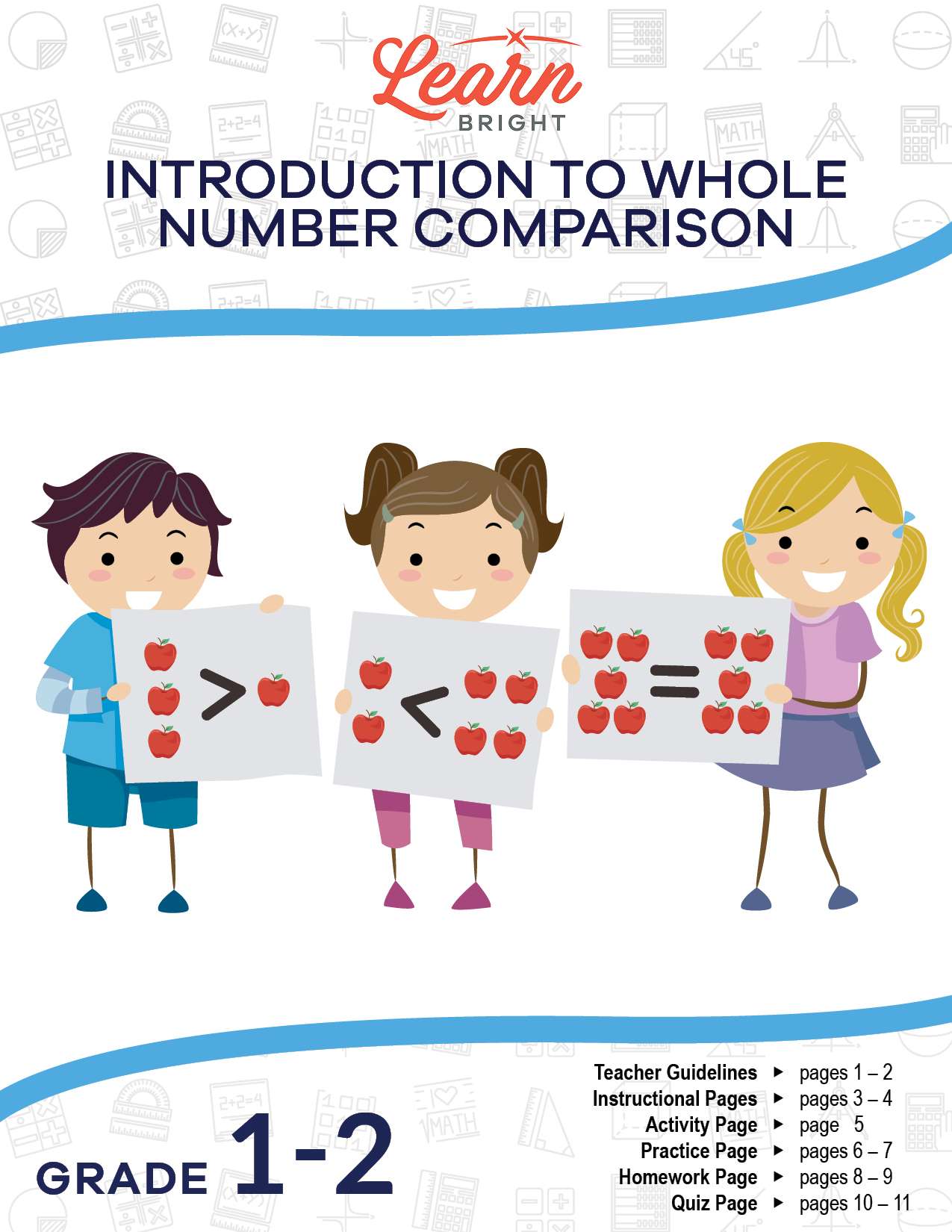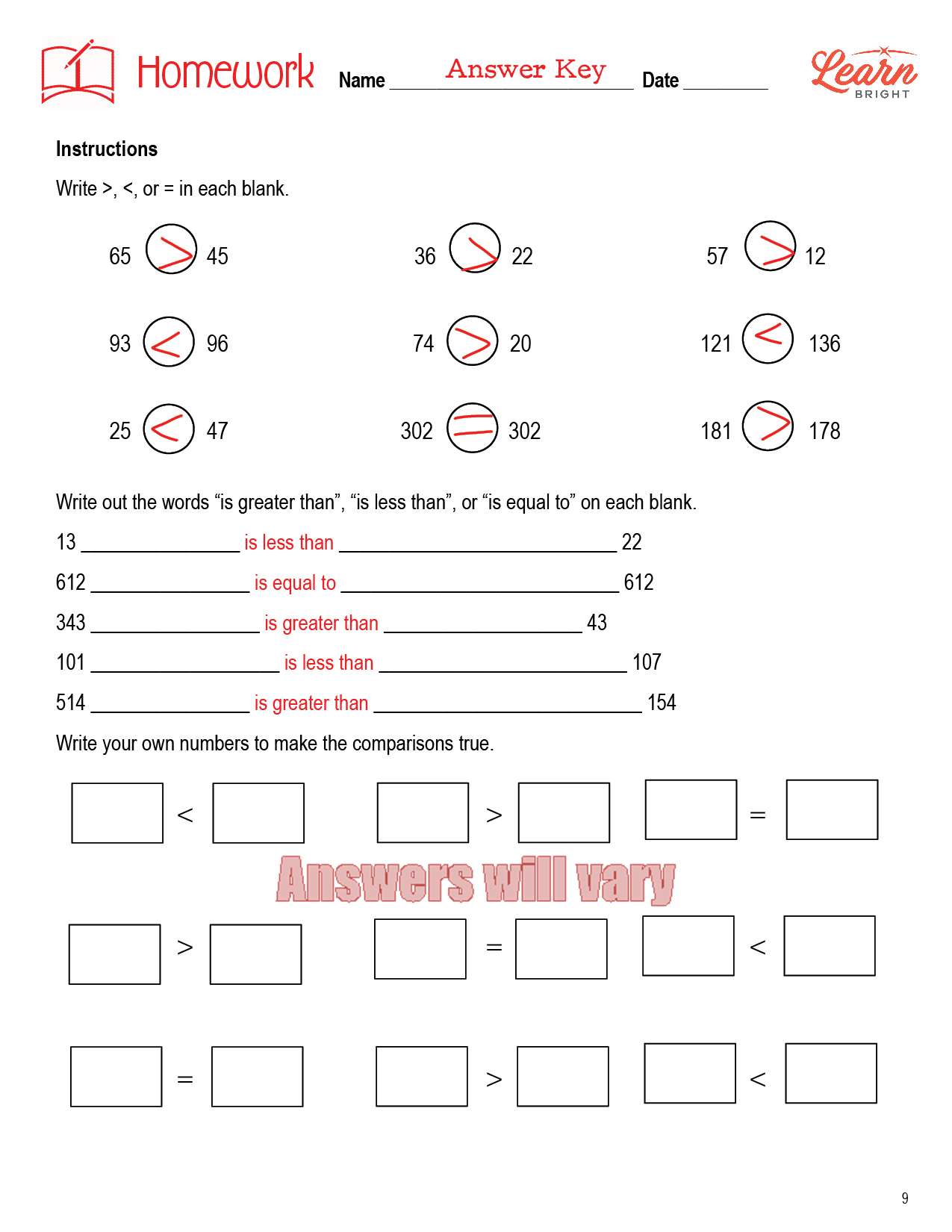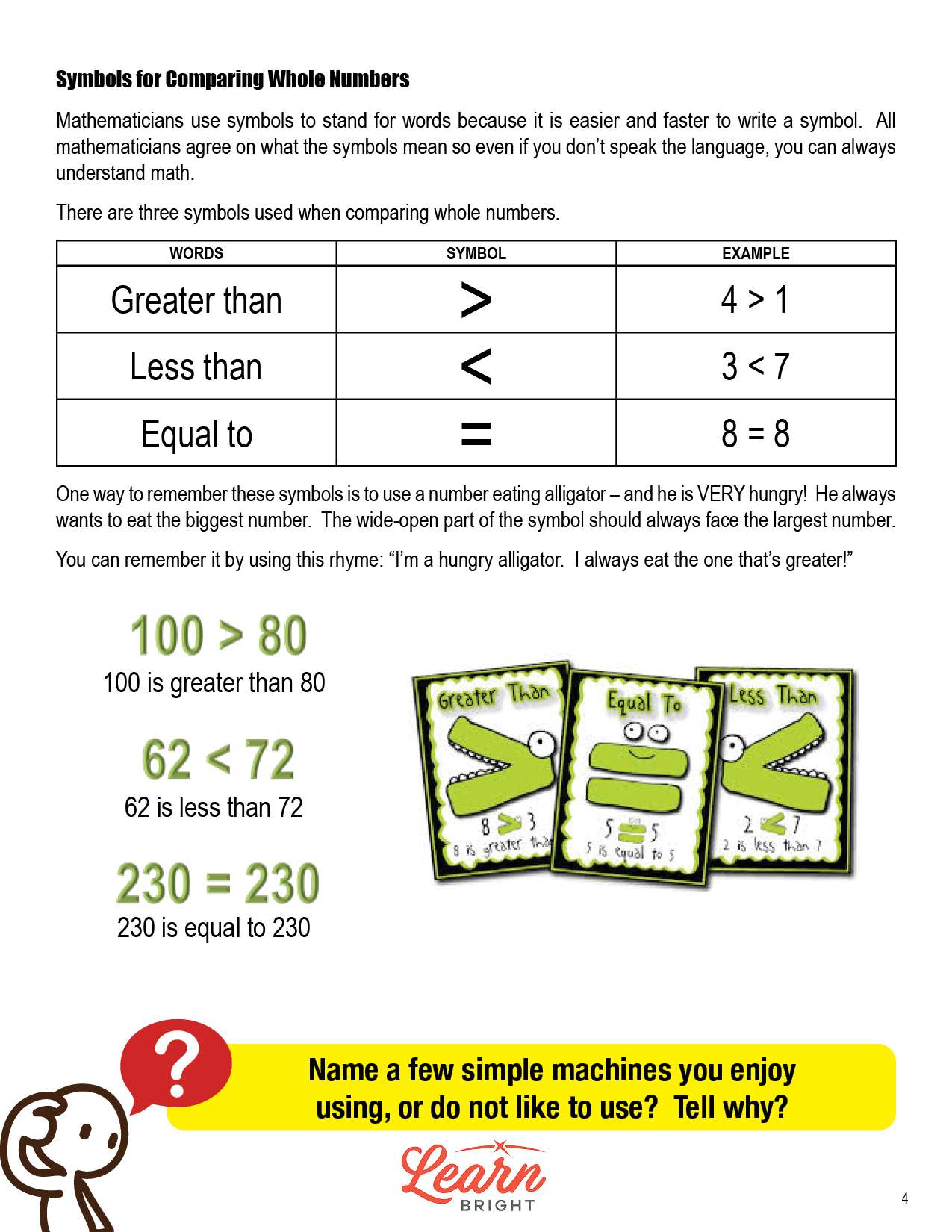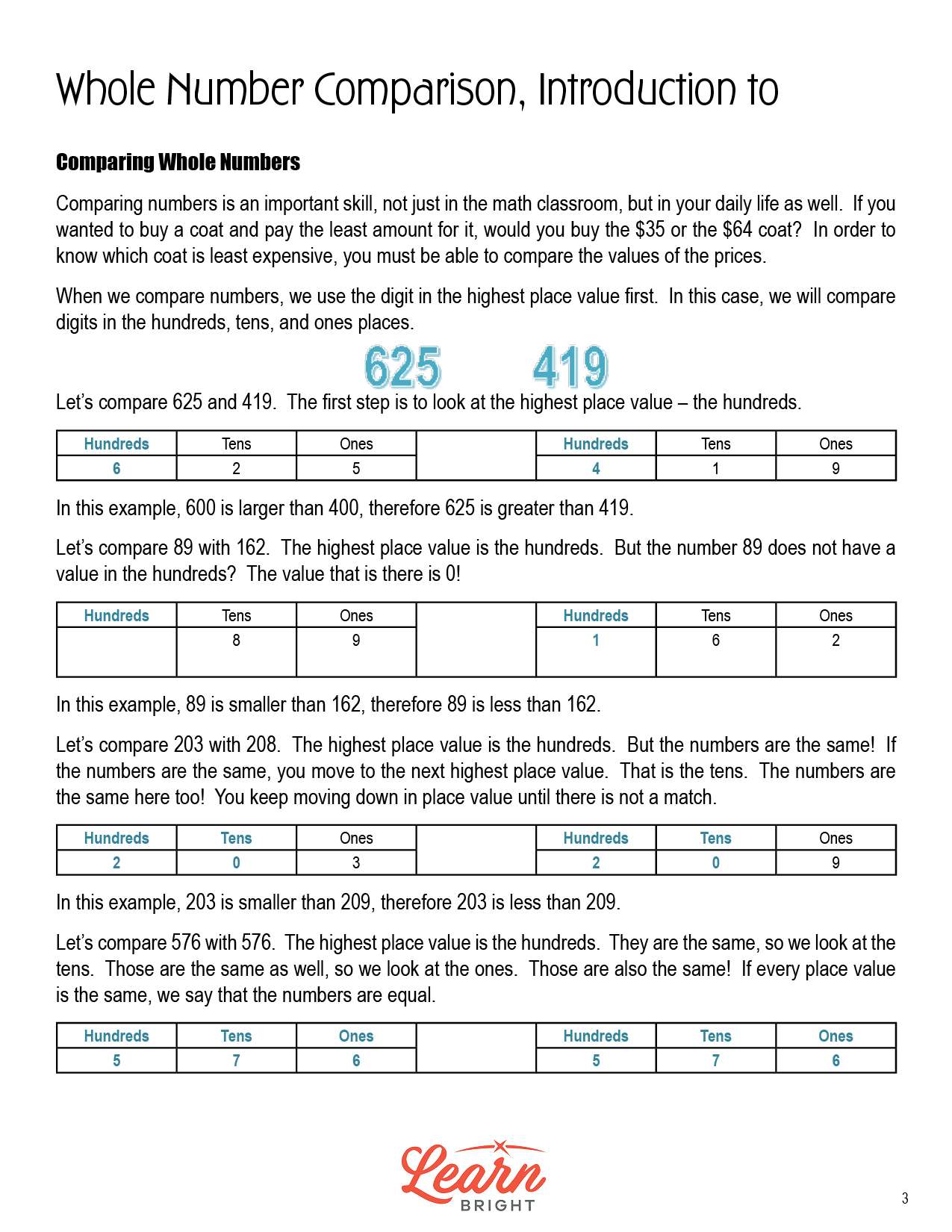Description
What our Introduction to Whole Number Comparison lesson plan includes
Lesson Objectives and Overview: Introduction to Whole Number Comparison exposes students to new number comparison symbols and vocabulary. At the end of the lesson, students will be able to compare numbers into the hundreds place. This lesson is for students in 1st grade and 2nd grade.
Classroom Procedure
Every lesson plan provides you with a classroom procedure page that outlines a step-by-step guide to follow. You do not have to follow the guide exactly. The guide helps you organize the lesson and details when to hand out worksheets. It also lists information in the orange box that you might find useful. You will find the lesson objectives, state standards, and number of class sessions the lesson should take to complete in this area. In addition, it describes the supplies you will need as well as what and how you need to prepare beforehand. The supplies you will need for this lesson includes popsicle sticks, wiggly eyes, colored paper, scissors, and glue.
Options for Lesson
Included with this lesson is an “Options for Lesson” section that lists a number of suggestions for activities to add to the lesson or substitutions for the ones already in the lesson. One optional addition to this lesson is to have your students use place value charts and erasable markers to practice putting the numbers in a place value chart and comparing them. If you have more advanced students, you can use larger numbers in the thousands or ten thousands. You could also give each of your students a number and call on them to compare their numbers. Finally, you can ask your students to find prices in magazines of two items and compare them.
Teacher Notes
The teacher notes page includes lines that you can use to add your own notes as you’re preparing for this lesson.
INTRODUCTION TO WHOLE NUMBER COMPARISON LESSON PLAN CONTENT PAGES
Comparing Whole Numbers
The Introduction to Whole Number Comparison lesson plan includes two content pages. It’s important to learn how to compare numbers, both in the math classroom and in your daily life. Say you wanted to buy a coat and wanted to pay the least amount you could for it. Would you buy a $35 coat or a $64 coat? To know which is cheaper, you need to compare the prices.
When you compare numbers, you start with the digit in the highest place value first. For example, let’s compare the numbers 625 and 419. First, we look at the highest place value: the hundreds. We can use a place value chart to help us. The lesson shows both of these numbers in a place value chart. When we look at the hundreds, we’re comparing 6 and 4. 6 is higher, so we know that 625 is greater than 419 without having to look at any of the other place values.
Next, let’s compare 89 and 162. The highest place value is the hundreds. However, the number 89 does not have a value in the hundreds, so its hundreds place value is 0. Therefore, we compare 0 and 1 to determine that 89 is less than 162.
Next, let’s compare 203 and 208. We look at the hundreds since that’s the largest place value. Both numbers have a 2 in their hundreds place, so we need to look at the tens instead. Both numbers have a 0 in their tens place, so we need to look at a smaller place value again! Finally, we look at the ones place. 3 is smaller than 9, so 203 is less than 209.
Finally, if you compare all of the place values and they’re all the same, the numbers are equal!
Symbols for Comparing Whole Numbers
In math, we use symbols to stand for words because they’re often easier and faster to write and understand. All mathematicians use the same symbols for the same things. No matter what language you speak, you can understand math!
We use three symbols to compare whole numbers: greater than (>), less than (<), and equal to (=). An easy way to remember these symbols is to think of an alligator who wants to eat the numbers. The alligator always wants to the bigger number, so he opens his mouth towards the larger number. The symbol should therefore always face the larger number. For example, 100 > 80 and 62 < 72.
INTRODUCTION TO WHOLE NUMBER COMPARISON LESSON PLAN WORKSHEETS
The Introduction to Whole Number Comparison lesson plan includes four worksheets: an activity worksheet, a practice worksheet, a homework assignment, and a quiz. You can refer to the guide on the classroom procedure page to determine when to hand out each worksheet.
HUNGRY ALLIGATOR ACTIVITY WORKSHEET
For the activity worksheet, students will create their own hungry alligators out of popsicle sticks. They can either use colored popsicle sticks or color in their own popsicle sticks. They will cut out teeth and eyes and glue them on to each alligator. Each student will make three alligators: one greater than, one less than, and one equal to.
Once students have created their alligators, they will use them to solve practice problems in the classroom. You can structure these practice problems in different ways. For example, you could have the students write numbers on a white board and place their alligators between or you can put two numbers on the board and have students put the correct symbol on their desk.
You can also encourage your students to use their alligators for their practice worksheet and homework assignment.
PLACE VALUE PRACTICE WORKSHEET
The practice worksheet asks students to first fill in the place value charts on the worksheet for different numbers. Next, they will write >, <, or = in each blank between the numbers listed on the worksheet. Finally, they will write out the words “is greater than”, “is less than”, or “is equal to” in each blank.
INTRODUCTION TO WHOLE NUMBER COMPARISON HOMEWORK ASSIGNMENT
For the homework assignment, students will first write >, <, or = in each blank between the numbers listed on the worksheet. Next, they will write out the words “is greater than”, “is less than”, or “is equal to” in each blank. Finally, they will write in their own numbers to make each comparison true.
QUIZ
This lesson also includes a quiz that you can use to test students’ understanding of the lesson material. For the quiz, students will first write >, <, or = in each blank between the numbers listed on the worksheet. They will then write the correct symbol for each descriptor (“is equal to,” “is greater than,” and “is less than”).
Worksheet Answer Keys
This lesson plan includes answer keys for the practice worksheet, the homework assignment, and the quiz. If you choose to administer the lesson pages to your students via PDF, you will need to save a new file that omits these pages. Otherwise, you can simply print out the applicable pages and keep these as reference for yourself when grading assignments.









